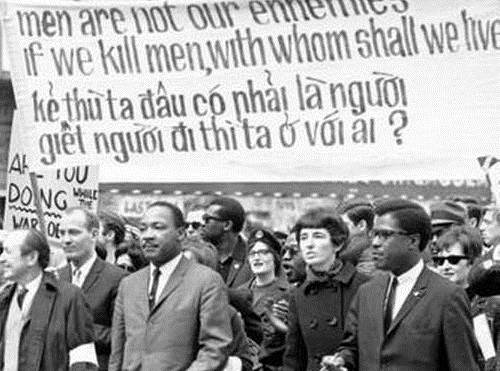
Kathy Kelly reflects on weapons and systems white people use to protect their white privilege, recalling that Dr. King called U.S. militarism “a demonic suction tube.”

Kathy Kelly reflects on weapons and systems white people use to protect their white privilege, recalling that Dr. King called U.S. militarism “a demonic suction tube.”
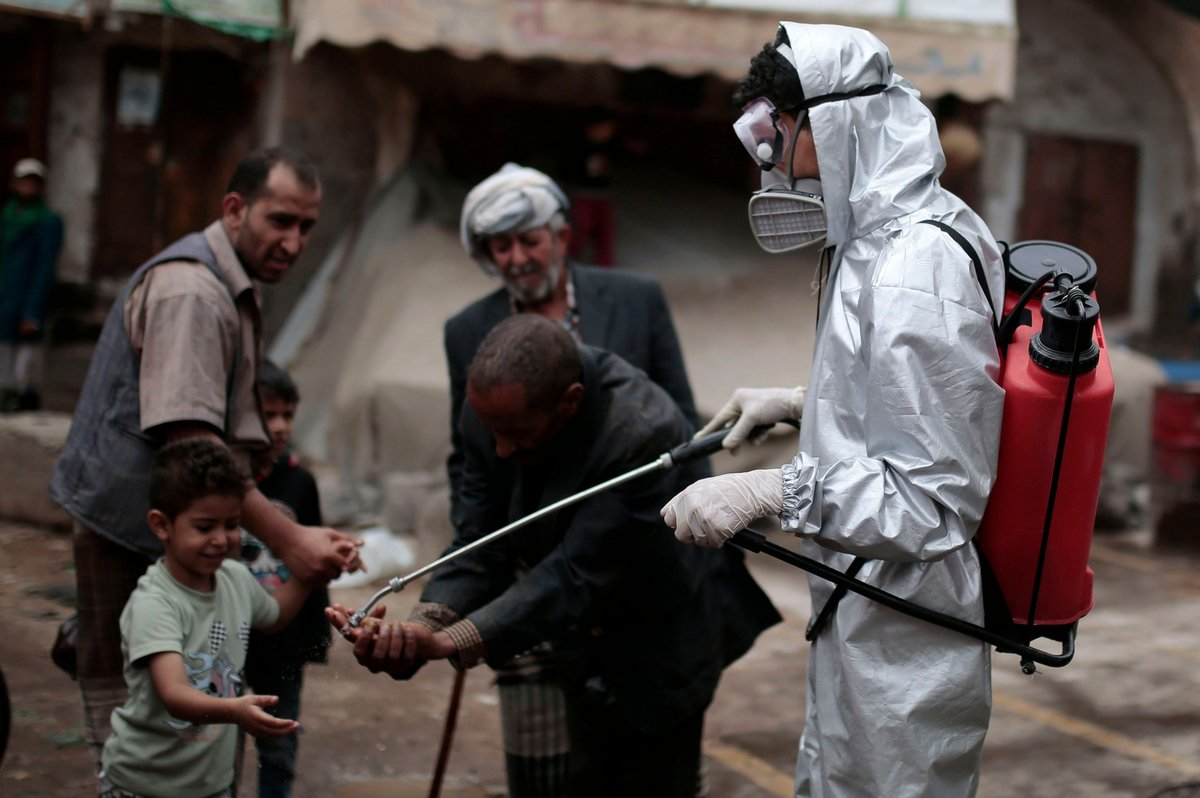
by Kathy Kelly
June 1, 2020
An entire generation of Yemeni children has suffered the traumas of war, many of them orphaned, maimed, malnourished, or displaced. The United Nations reports a death toll of 100,000 people in that nation’s ongoing war, with an additional
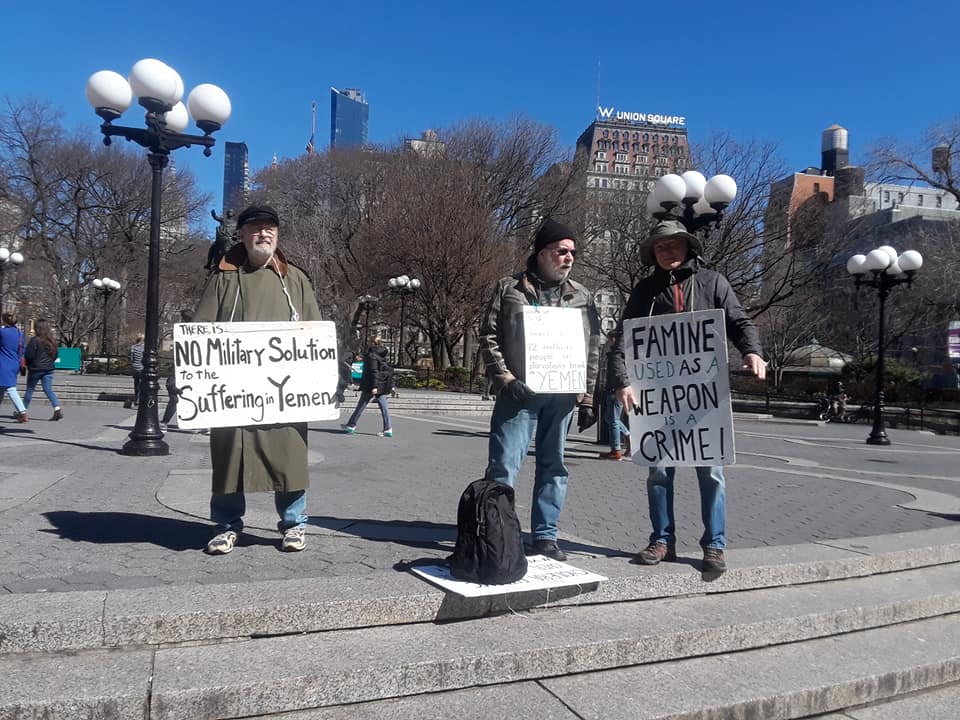
March 27, 2020
For the past three years, several dozen New Yorkers have gathered each Saturday at Union Square, at 11:00 a.m. to vigil for peace in Yemen.
Now, however, due to the coronavirus, the vigil for peace is radically altered. Last week, in recognition of the city’s coming shelter in place program, participants were asked to hold individual vigils at their respective homes on the subsequent Saturday mornings. Normally, during the public vigils, one or more participants would provide updates on the humanitarian crisis in Yemen, the ongoing war, and U.S. complicity. As COVID-19 threatens to engulf war-torn Yemen, it is even more critical to raise awareness of how the war debilitates the country.
If the vigil for peace were to gather in Union Square this Saturday, activists most certainly would draw attention to how Turkish officials indicted 20 Saudi nationals for the murder of the dissident writer, Jamal Khashoggi. Turkey’s investigation of the murder and dismemberment of Mr. Khashoggi indicts 18 people for committing the murder and names two officials for incitement to murder. One of them, General Ahmad Al-Asiri, a close associate of the Kingdom of Saudi Arabia’s Crown Prince Mohammed bin Salman, was deputy chief of intelligence when Mr. Khashoggi was murdered.
Numerous news reports over the past five years establish a pattern of Mr. Al-Asiri responding to inquiries about Saudi-led coalition military attacks against Yemen civilians with misleading statements, outright denials and attempted cover-ups.
For example, On August 30th, 2015, according to Human Rights Watch, a Saudi coalition led airstrike attacked the Al-Sham Water Bottling Factory in the outskirts of Abs, in northern Yemen. The strike destroyed the factory and killed 14 workers, including three boys, and wounded 11 more.
Later on August 30, after the airstrike, Gen. Al-Asiri told Reuters that the plant was not a bottling factory, but rather a place where Houthis made explosive devices. However, all of the individuals Human Rights Watch interviewed concurred:
…that plant was being used to bottle water and was not used for any military purposes… A group of international journalists traveled to the site of the blast two days after it was hit and reported that they could not find evidence of any military targets in the area. They said that they carefully examined the site, and took photos and videos of piles of scorched plastic bottles melted together from the heat of the explosion. They could not find any evidence that the factory was being used for military purposes.
Meanwhile, Yemenis were desperately trying to contend with rising cases of cholera caused by shortages of clean water.
In October, 2015, when eyewitnesses declared a hospital in northern Yemen run by Doctors Without Borders was destroyed by Saudi-led coalition warplanes, Gen. Al-Asiri told Reuters coalition jets had been in action over Saada governorate but had not hit the hospital.
On August 15, 2016, a Saudi-led bombing campaign again targeted a hospital in northern Yemen supported by Doctors Without Borders. 19 people were killed.
The Abs hospital was bombed two days after Saudi airstrikes attacked a school in northern Yemen, killing ten students and wounding dozens more.
Yet Saudi officials continued to insist they struck military targets only. Commenting on the August 13 school attack, Gen. Al-Asiri said the dead children were evidence the Houthis were recruiting children as guards and fighters.
“We would have hoped,” General Al-Asiri said, that Doctors Without Borders “would take measures to stop the recruitment of children to fight in wars instead of crying over them in the media.”
In one of the deadliest attacks of the war, on October 8, 2016, the Saudi-led military coalition’s fighter jets repeatedly bombed a hall filled with mourners during a funeral for an official in the capital city of Sana. At least 140 people were killed and 550 more were wounded.
General Al-Asiri, still a spokesman for the Saudi-led coalition, suggested there were other causes for the blast and later reported the coalition had not carried out any strikes near the hall. But outraged U.N. officials, backed up by videos on social media, insisted that airstrikes had massacred the mourners.
The U.S. has steadily sided with Saudi Arabia, including supplying it with weapons, training its armed forces and covering for it in the United Nations Security Council. But “Defense One,” a U.S. news agency intending to provide news and analysis for national security leaders and stakeholders, recently issued a stinging rebuke to the Kingdom’s Crown Prince, Mohammed bin Salman. They denounced the “humanitarian abomination ushered by Riyadh’s war in Yemen,” and called his leadership “as destabilizing to the Middle East as its Iranian rival.” Defense One urged Washington to discontinue enabling “Riyadh’s most reckless behavior.”
Turkey’s indictment of 20 Saudi nationals for murder and their insistence that Mr. Al-Asiri bears responsibility may help move the court of public opinion to resist all support for the Kingdom’s ongoing war in Yemen.
Particularly now, with intense focus on U.S. health care, it’s timely to recognize that in the past five years U.S. supported Gulf Coalition airstrikes bombed Yemen’s health care facilities 83 times. As parents here care for children during school closures, they should be reminded that since December 13, 2018, eight Yemeni children have been killed or injured every single day. Most of the children killed were playing outdoors with their friends or were on their way to or from school. According to the Yemen Data Project, more than 18,400 civilians have been killed or injured by Saudi Arabia and its Gulf allies since the initial bombing campaign in 2015.
U.S. national security leaders and stakeholders in war, as they shelter in place, have an extraordinary opportunity to set a new norm and link with the vigil for Peace in Yemen, virtually. And, some may even join Yale students on April 9, from sunrise to sunset, in their National Fast for Peace in Yemen. They invite us to pledge support for Doctors Without Borders and other relief groups in Yemen.
Photo (Bill Ofenloch): Activists practice “physical distancing” at a Saturday morning vigil for Peace in Yemen, Union Square, NYC
Kathy Kelly (kathy@vcnv.org) co-coordinates Voices for Creative Nonviolence
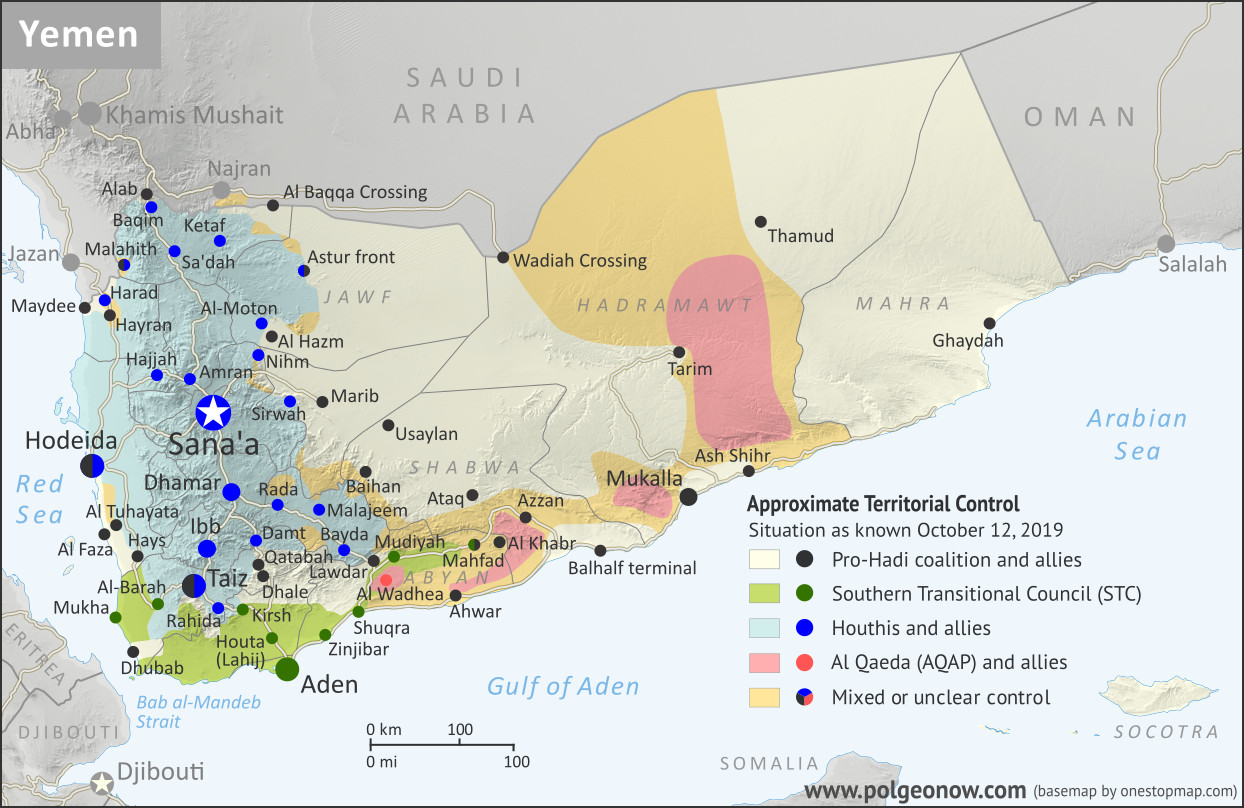
by Kathy Kelly
October 16, 2019
Writing about his visit to the world’s largest weapons bazaar, held in London during October, Arron Merat describes reading this slogan emblazoned above Raytheon’s stall: “Strike with Creativity.” Raytheon manufactures Paveway laser-guided bombs, fragments of which have been found in the wreckage of schools, hospitals, and markets across Yemen. How can a weapons manufacturer that causes such death, bloodshed, and misery lay claim to creativity?
Greta Thunberg, sitting alone outside her school as she initiated a movement of climate strikes, could properly invoke the words “Strike with Creativity.” She inspired Friday classroom walkouts, worldwide, by young people protesting destruction and death caused by climate catastrophe. Her admirable goal is to save the planet by promoting such strikes.
Coming from Raytheon, the words “Strike with Creativity” sound chilling, -grotesque.
Consider the Raytheon weapons now demolishing Yemen. Fragments of Raytheon and other U.S. manufactured weapons dot blast sites where Yemeni survivors struggle to collect body parts and scattered bits of clothing, which are needed to compile lists of the dead.
In September, the Kingdom of Saudi Arabia (KSA) hit a detention center in the Dhamar governorate, in the northern highlands of Yemen with seven airstrikes that killed at least 100 people and “pulverized” the area, according to Bethan McKernan, reporting for The Guardian. “It took five days to remove all the bodies impaled on metalwork ripped from the walls in the blasts,” she wrote.
After the attack, McKernan interviewed Adel, a 22-year-old security guard employed at the site. His brother, Ahmed, also a guard, was among those killed. Adel pointed to a blanket, visible on the second floor of a building where the guards had slept. “You can see Ahmed’s blue blanket up there,” said Adel. “There were 200 people here but now it’s just ghosts.”
Saudi Arabia and other countries in the Saudi-led coalition bombarding and blockading Yemen have killed tens of thousands, wrecking the country’s already enfeebled infrastructure and bringing Yemen to the brink of a famine that may kill millions. President Trump signaled additional support for Saudi Arabia on October 11 when the U.S. military announced it would send thousands more troops to the kingdom, bringing the number of U.S. troops there to 14,000.
Just as Greta Thunberg insists adults must become intensely aware of details and possible solutions regarding the climate catastrophe, people in the U.S. should learn about ways to end economic as well as military war waged against Yemen. For us to understand why Yemenis would link together in the loose coalition of fighters called Huthis requires deepening awareness of how financial institutions, in attempting to gain control of valuable resources, have pushed farmers and villagers across Yemen into debt and desperation. Isa Blumi writes about this sordid history in his 2018 book, Destroying Yemen, What Chaos in Arabia Tells Us about the World.
Blumi details how Yemen’s society, largely independent and agrarian, became a guinea pig for International Monetary Fund (IMF) “development projects” which, based on strikingly colonialist theories of modernization, crushed grassroots institutions and amounted to “cost-effective ways of prying Yemen’s wealth out of its peoples’ hands.”
Local Development Associations, for example, were formed during the 1970s to help people hang on to their land, cooperatively determine what crops they would grow and decide how they would use the profits. But U.S. Agency for International Development “experts” pressured these groups to instead produce “cash crops strictly meant for export.”
“After all,” Blumi writes, “with the right kind of cash crop and the use of American labor-saving technology, pesticides and fertilizers included, Yemen’s villagers were no longer needed in the fields. Alternatively, they could work in cities in sweatshops producing clothes for a global market or the soon booming oil and gas projects.”
Blumi’s book documents the fiercely stubborn creativity with which, decade by decade, Yemenis kept surprising the West, exploring and pursuing countermeasures to resist its exploitative control, and risking the West’s destructive anger.
Yemenis resisted U.N. and IMF prescriptions of global integration and debt peonage. When farmers desperate for cash went to work in, for instance, Saudi Arabia, “they consistently sent remittances home to families that saved the cash and invested in local projects, using local bank transfers.” Imams and village leaders encouraged people to resist imperialist “modernization” projects, knowing that the West’s preferred “modern” role for them was as wage slaves with no hope of developing a better future.
The “Huthi” movement began when Husayn al-Huthi, an opponent of Yemen’s dictatorial (and Western-allied) Saleh regime, tried to defend the water and land rights of locals in the Sa’adah province in northwestern Yemen. Sharing what was then a porous and informal border with the KSA, they often found themselves in disputes with Saudi border patrols. They also resisted ‘structural adjustment’ demands by the IMF to privatize some of Yemen’s best farming and grazing land. When the dictator Saleh made criminal concessions to the KSA, al-Huthi and his followers persisted with protests. Each new confrontation won over thousands of people, eventually spreading beyond Sa’adah.
Blumi cites numerous instances in which Yemen’s economic assets were pillaged, with Saleh’s approval, by “well-heeled global financial interests” who now designate Saleh’s successor Abdrabbuh Mansur Hadi as Yemen’s “internationally recognized government.” Hadi governs from Riyadh in Saudi Arabia, due to a stunning lack of Yemeni support.
In 2008, an extremely wealthy member of the bin Laden family aimed to build a bridge across the mouth of the Red Sea from Yemen to Djibouti. The project could generate hundreds of billions for investors, and quicken the process of exploitative modernization; but it would also require building railways and roads where there are only villages now. People living along the coastline of the Red Sea would be in the way.
Since 2015, fighting has been concentrated in this area, called the Tihama. Control of the coastline would also allow financial takeover of potentially profitable Yemeni fisheries. Blumi says billions of dollars of annual income are at stake, noting with irony that a war causing starvation is being waged, in part, to gain control over food assets.
A recent United Nations report says that Yemen is now “on course to become the world’s poorest country” with 79 percent of the population living under the poverty line and 65 percent classified as “extremely poor.” The Yemen Data Project estimated 600 civilian structures have been destroyed, monthly, in Yemen, mostly by airstrikes.
“Staple food items are now on average 150 per cent higher than before the crisis escalated,” says a 2019 report by the Norwegian Refugee Council. “Teachers, health workers and civil servants in the northern parts of the country haven’t been paid in years,” according to the same report.
Mainstream media reports could convince concerned onlookers that Yemenis have been particularly vulnerable to violence and war because they are socially and economically backward, having failed to modernize. Blumi insists we recognize the guilt of financial elites from multiple countries within and beyond the Gulf states as well as institutions within the World Bank, the IMF and the UN. It’s wrong to blame “eighty percent of a country’s population currently being starved to death”
Here in the United States, news commentators discussing the Trump impeachment story liken the breaking developments to “bombshell after bombshell.” In Yemen, real and horribly modern bombshells, made in the United States, kill and maim Yemeni civilians, including children, every day.
Greta Thunberg continues calling us to join her on an unfamiliar, unprecedented, and arduous path to change course as our world careens toward terrifying devastation. We’re offered a chance to resist destructive, albeit “modern” means of exploiting the planet’s resources. A true strike for creativity, necessarily challenging militarism and greed, will help prevent the hellish work of destroying Yemen.
Kathy Kelly (kathy@vcnv.org) co-coordinates Voices for Creative Nonviolence (www.vcnv.org)
A version of this article was first published in The Progressive online magazine.
Map credit: Political Geography Now
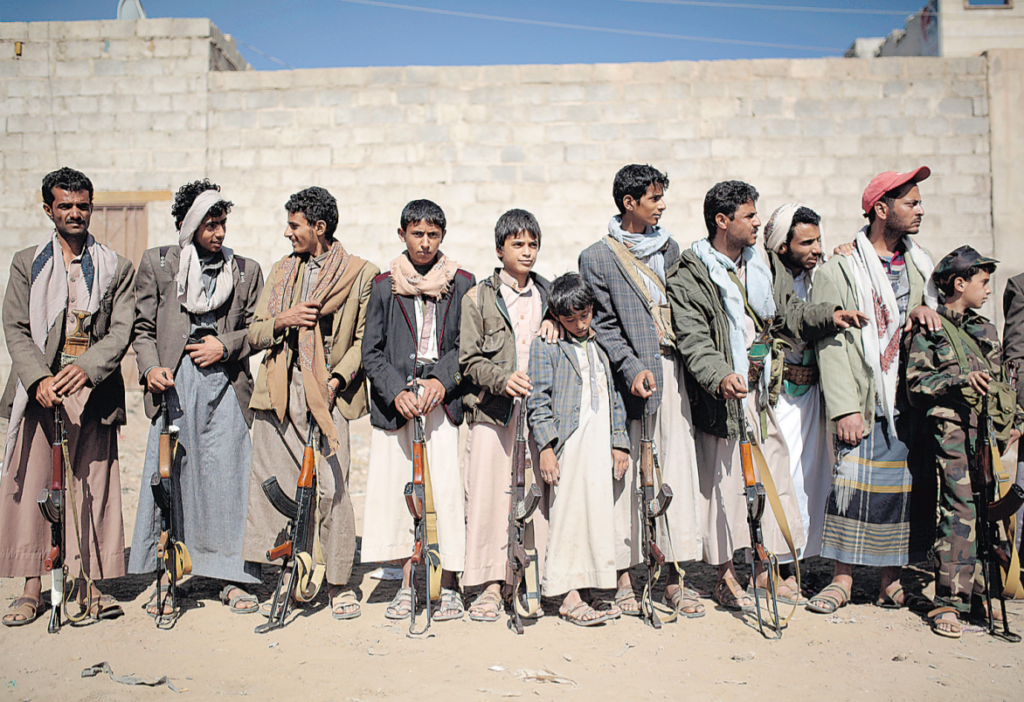
Photo: Houthi-allied tribesmen demonstrating in Yemen for peace talks – Hani Mohammed/AP
December 19, 2018
Twenty years ago, a small delegation organized by Voices in the Wilderness lived in Baghdad while U.S. cruise missiles attacked more than 100 targets in Iraq. Following four days of bombing, known as “Operation Desert Fox,” our group visited various Iraqis who had survived direct hits. One young girl handed me a large missile fragment, saying “Merry Christmas.”
An engineer, Gasim Risun, cradled his two-week old baby as he sat in his hospital bed. Gasim had suffered multiple wounds, but he was the only one in his family well enough to care for the infant, after an unexploded missile destroyed his house. In Baghdad, a bomb demolished a former military defense headquarters, and the shock waves shattered the windows in the hospital next door. Doctors said the explosions terrified women in the maternity ward, causing some to spontaneously abort their babies while others went into premature labor.
In December 1998, U.S. news media steadily focused on only one person living in Iraq: Saddam Hussein. With the notable exception of Stephen Kinzer of The New York Times, no mainstream media focused on U.N. reports about the consequences of U.S. economic sanctions imposed on Iraq. One of Kinzer’s articles was headlined: “Iraq a Pediatrician’s Hell: No Way to Stop the Dying.”
The hellish conditions continued, even as U.N. officials sounded the alarm and explained how economic sanctions directly contributed to the deaths of hundreds of thousands of children under age five.
Now a horror story of similar proportions is playing out in Yemen.
—
In November 2018, The Guardian reported that up to 85,000 Yemeni children under age five have died from starvation and disease during the last three years. Mainstream media and even governments of large and wealthy countries are finally beginning to acknowledge the anguish suffered by Yemeni children and their families.
Stark and compelling photos show listless, skeletal children who are minutes or days away from death. Reports also show how war plans have deliberately targeted Yemen’s infrastructure, leading to horrifying disease and starvation. Journalists who have met with people targeted as Houthi fighters, many of them farmers and fishermen, describe how people can’t escape the sophisticated U.S. manufactured weapons fired at them from massive warplanes.
One recent Associated Press photo, on page one of The New York Times for December 14, shows a line of tribespeople loyal to the Houthis. The youngest child is the only one not balancing a rifle upright on the ground in front of him. The tribespeople bear arms, but they are poorly equipped, especially compared to the U.S.-armed Saudis.
Since 2010, according to The New York Times, the United States has sold the Saudis thirty F-15 multirole jet fighters, eighty-four combat helicopters, 110 air-to-surface cruise missiles, and 20,000 precision guided bombs. Last year, the United States also sold the Saudis ten maritime helicopters in a $1.9 billion deal. An American defense contractor, Booz Allen Hamilton, “earned tens of millions of dollars training the Saudi Navy during the past decade.”
—
Earlier this year, Saudi Arabia’s Crown Prince Mohammed bin Salman—along with his counterpart in the United Arab Emirates, Mohammed bin Zayed—seemed untouchable. He was feted and regaled by former Presidents, Oprah, Hollywood show biz magnates, and constant media hype.
Now, the U.S. Senate has passed a resolution holding him accountable for the gruesome murder of Saudi journalist Jamal Khashoggi. Several U.S. Senators have said they no longer want to be responsible for bloodshed he has caused in Yemen. U.N. negotiators have managed to broker a fragile ceasefire, now in effect, which will hopefully stop the fighting that has raged in the vital port city of Hodeidah. One message which may have prompted the Saudis to negotiate came in the form of a Senate vote threatening to curtail the support of U.S. armed forces for the Saudi-led Coalition’s war on Yemen.
I doubt these actions will bring solace or comfort to parents who cradle their listless and dying children. People on the brink of famine cannot wait days, weeks, or months while powerful groups slowly move through negotiations.
And yet, a shift in public perception regarding war on Yemen could liberate others from the terrible spectre of early death.
Writing during another war, while he was exiled from Vietnam, Buddhist monk Thich Nhat Hanh imagined the birth of a “Peace Child.” He ends his poem by calling on people to give both their hands for the chance to “protect the seeds of life bursting on the cradle’s rim.”
I think of Iraqi mothers who lost their babies as bombs exploded just outside their maternity ward. The shift in public perception is painfully too late for innumerable people traumatized and bereaved by war. Nevertheless, the chance to press with all our might for a continuing and growing shift, repudiating war, could point us in a new direction.
The war in Yemen is horrific and ought to be ended immediately. It makes eminent good sense to give both our hands and all the energies we can possibly summon, to end the war in Yemen and vow the abolition of all war.
A version of this article first appeared on the website of The Progressive magazine.
Kathy Kelly (kathy@vcnv.org) co-coordinates Voices for Creative Nonviolence (www.vcnv.org) which is organizing a two week “Voices Rising – Fast for Yemen” beginning in NYC December 29, 2018 for the first week. During the second week, Jan. 6 – 12, participants will join the Witness Against Torture fast in Washington, D.C.
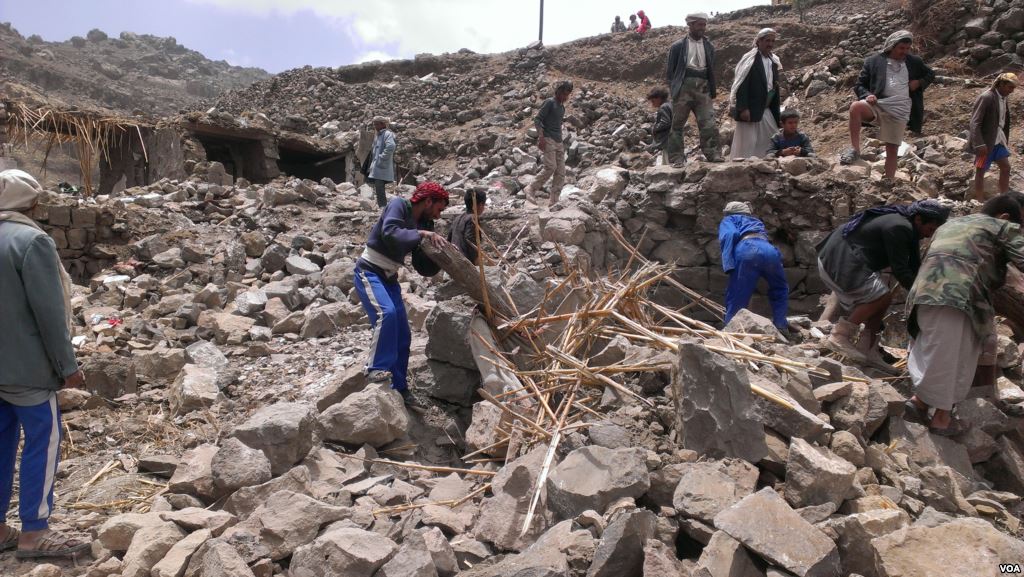
Several days ago, I joined an unusual Skype call originated by young South Korean founders of “The Hope School.” Located on Jeju Island, the school aims to build a supportive community between island residents and newly arrived Yemenis who seek asylum in South Korea.
Jeju, a visa-free port, has been an entry point for close to 500 Yemenis who have traveled nearly 5000 miles in search of safety. Traumatized by consistent bombing, threats of imprisonment and torture, and the horrors of starvation, recent migrants to South Korea, including children, yearn for refuge.
Like many thousands of others who’ve fled Yemen, they miss their families, their neighborhoods, and the future they once might have imagined. But returning to Yemen now would be awfully dangerous for them.
Whether to welcome or reject Yemenis seeking asylum in South Korea has been a very difficult question for many who live on Jeju Island. Based in Gangjeong, a city long renowned for brave and tenacious peace activism, the founders of “The Hope School” want to show newly arrived Yemenis a respectful welcome by creating settings in which young people from both countries can get to know one another and better understand each other’s history, culture and language.
They regularly gather for exchanges and lessons. Their curriculum suggests solving problems without relying on weapons, threats, and force. In the “Seeing Yemen from Jeju” seminar, I was asked to speak about grass roots efforts in the U.S. to stop the war in Yemen. I mentioned Voices has helped arrange demonstrations against war on Yemen in many U.S. cities and that, relative to other antiwar campaigns we’ve participated in, we’ve seen some willingness within the mainstream media to cover the suffering and starvation caused by the war on Yemen.
One Yemeni participant, himself a journalist, voiced exasperated frustration. Did I understand how trapped he and his companions are? In Yemen, Houthi fighters could persecute him. He could be bombed by Saudi and UAE warplanes; mercenary fighters, funded and organized by the Saudis or the UAE might attack him; he would be equally vulnerable to Special Operations forces organized by western countries, such as the U.S. or Australia. What’s more, his homeland is subject to exploitation by major powers greedily seeking to control its resources. “We are caught in a big game,” he said.
Another young man from Yemen said he envisions an army of Yemenis that would defend all people living there from all the groups now at war in Yemen.
Hearing this, I remembered how adamantly our young South Korean friends have opposed armed struggle and the militarization of their island. Through demonstrations, fasts, civil disobedience, imprisonments, walks, and intensive campaigns designed to build solidarity, they’ve struggled, for years, to resist the onslaughts of South Korean and U.S. militarism. They understand well how war and ensuing chaos divides people, leaving them ever more vulnerable to exploitation and plunder. And yet, they clearly want everyone in the school to have a voice, to be heard, and to experience respectful dialogue.
How do we, in the U.S., develop grass roots communities dedicated to both understand the complex realities Yemenis face and work to end U.S. participation in the war on Yemen? Actions taken by our young friends who organized “The Hope School” set a valuable example. Even so, we must urgently call on all the warring parties to enact immediate cease-fires, open all ports and roads so desperately needed distribution of food, medicine and fuel can take place, and help restore Yemen’s devastated infrastructure and economy.
In numerous U.S. locations, activists have displayed 40 backpacks to remember the forty children killed by a 500-pound Lockheed Martin missile that targeted their school bus on August 9, 2018.
In the days before August 9th, each child had received a UNICEF-issued blue backpack filled with vaccines and other valuable resources to help their families survive. When classes resumed some weeks ago, children who had survived the terrible bombing returned to school carrying bookbags still stained by spattered blood. Those children desperately need reparations in the form of practical care and generous “no-strings attached” investments to help them find a better future. They need “The Hope School” too.
Killing people, through war or starvation, never solves problems. I strongly believe this. And I believe heavily armed elites, intending to increase their personal wealth, have regularly and deliberately sown seeds of division in Iraq, Afghanistan, Syria, Gaza and other lands wherein they desire to control precious resources. A divided Yemen would allow Saudi Arabia, the United Arab Emirates, their coalition partners, and the U.S. to exploit Yemen’s rich resources for their own benefit.
As wars rage on, every voice crying out in affliction should be heard. Following “The Hope School” seminar, I imagine we could all agree that an excruciatingly crucial voice wasn’t present in the room: that of a child, in Yemen, too hungry to cry.
Kathy Kelly (kathy@vcnv.org) co-coordinates Voices for Creative Nonviolence (www.vcnv.org)
Photo: Villagers scour rubble for belongings scattered during the bombing of Hajar Aukaish, Yemen, in April 2015. Photo credit: Almigdad Mojalli/VOA
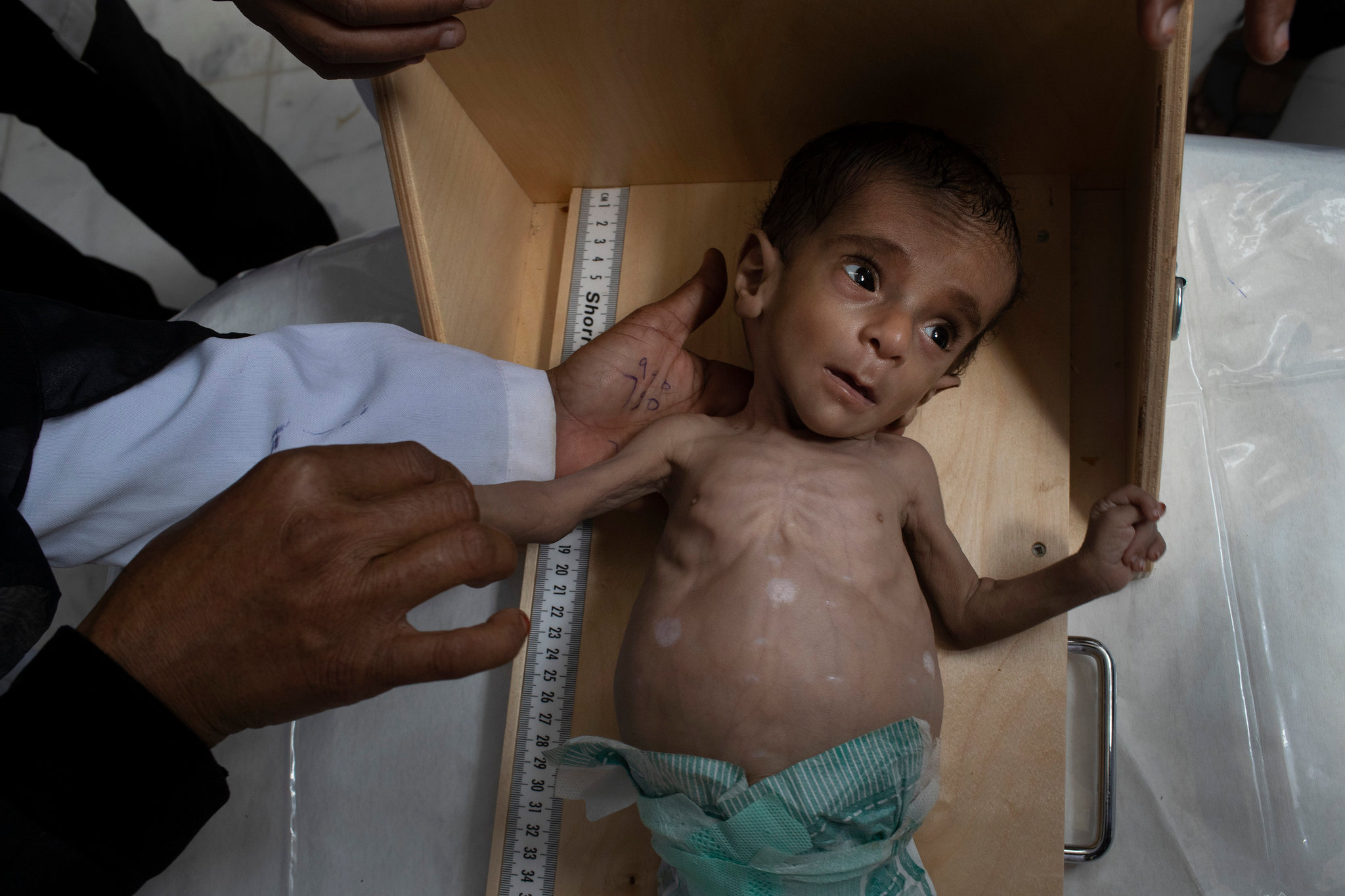
Above: 11 month old Wadah Askri Mesheel in a Yemen clinic, 8 hours before his death from malnutrition.
Photo credit: Tyler Hicks/NYT
November 29, 2018
On November 28, sixty-three U.S. Senators voted in favor of holding a floor debate on a resolution calling for an end to direct U.S. Armed Forces involvement in the Saudi-UAE coalition-led war on Yemen. Describing the vote as a rebuke to Saudi Arabia and the Trump Administration, AP reported on Senate dissatisfaction over the administration’s response to Saudi Arabia’s brutal killing of Jamal Khashoggi last month. Just before the Senate vote, Secretary of State Mike Pompeo called current objections to U.S. relations with Saudi Arabia “Capitol Hill caterwauling and media pile-on.”
The “caterwaul” on Capitol Hill reflects years of determined effort by grassroots groups to end U.S. involvement in war on Yemen, fed by mounting international outrage at the last three years of war that have caused the deaths of an estimated 85,000 Yemeni children under age five.
When children waste away to literally nothing while fourteen million people endure conflict-driven famine, a hue and cry—yes, a caterwaul —most certainly should be raised, worldwide.
How might we understand what it would mean in the United States for fourteen million people in our country to starve? You would have to combine the populations of New York, Chicago, and Los Angeles, and imagine these cities empty of all but the painfully and slowly dying, to get a glimpse into the suffering in Yemen, where one of every two persons faces starvation.
Antiwar activists have persistently challenged elected representatives to acknowledge and end the horrible consequences of modern warfare in Yemen where entire neighborhoods have been bombed, displacing millions of people; daily aerial attacks have directly targeted Yemen’s infrastructure, preventing delivery of food, safe water, fuel, and funds. The war crushes people through aerial bombing and on-the-ground fighting as well as an insidious economic war.
Yemenis are strangled by import restrictions and blockades, causing non-payment of government salaries, inflation, job losses, and declining or disappearing incomes. Even when food is available, ordinary Yemenis cannot afford it.
Starvation is being used as a weapon of war—by Saudi Arabia, by the United Arab Emirates, and by the superpower patrons including the United States that arm and manipulate both countries.
During the thirteen years of economic sanctions against Iraq— those years between the Gulf War and the devastating U.S.-led “Shock and Awe” war that followed—I joined U.S. and U.K. activists traveling to Iraq in public defiance of the economic sanctions.
We aimed to resist U.S.- and U.K.-driven policies that weakened the Iraqi regime’s opposition more than they weakened Saddam Hussein. Ostensibly democratic leaders were ready to achieve their aims by brutally sacrificing children under age five. The children died first by the hundreds, then by the thousands and eventually by the hundreds of thousands. Sitting in a Baghdad pediatric ward, I heard a delegation member, a young nurse from the U.K., begin to absorb the cruelty inflicted on mothers and children.
“I think I understand,” murmured Martin Thomas, “It’s a death row for infants.” Children gasped their last breaths while their parents suffered a pile-up of anguish, wave after wave. We should remain haunted by those children’s short lives.
Iraq’s children died amid an eerie and menacing silence on the part of mainstream media and most elected U.S. officials. No caterwauling was heard on Capitol Hill.
But, worldwide, people began to know that children were paying the price of abysmally failed policies, and millions of people opposed the 2003 Shock and Awe war.
Still the abusive and greedy policies continue. The U.S. and its allies built up permanent warfare states to secure consistent exploitation of resources outside their own territories.
During and after the Arab Spring, numerous Yemenis resisted dangerously unfair austerity measures that the Gulf Cooperation Council and the U.S. insisted they must accept. Professor Isa Blumi, who notes that generations of Yemeni fighters have refused to acquiesce to foreign invasion and intervention, presents evidence that Saudi Arabia and the UAE now orchestrate war on Yemen to advance their own financial interests.
In the case of Saudi Arabia, Blumi states that although Crown Prince Mohammad bin Salman wants to author an IPO (Initial Public Offering), for the Saudi state oil company, Aramco, no major investors would likely participate. Investment firms know the Saudis pay cash for their imports, including billions of dollars’ worth of weaponry, because they are depleting resources within their own territory. This, in part, explains the desperate efforts to take over Yemen’s offshore oil reserves and other strategic assets.
Recent polls indicate that most Americans don’t favor U.S. war on Yemen. Surely, our security is not enhanced if the U.S. continues to structure its foreign policy on fear, prejudice, greed, and overwhelming military force. The movements that pressured the U.S. Senate to reject current U.S. foreign policy regarding Saudi Arabia and its war on Yemen will continue raising voices. Collectively, we’ll work toward raising the lament, pressuring the media and civil society to insist that slaughtering children will never solve problems.
This article first appeared on the website of The Progressive magazine.
Kathy Kelly co-coordinates Voices for Creative Nonviolence www.vcnv.org
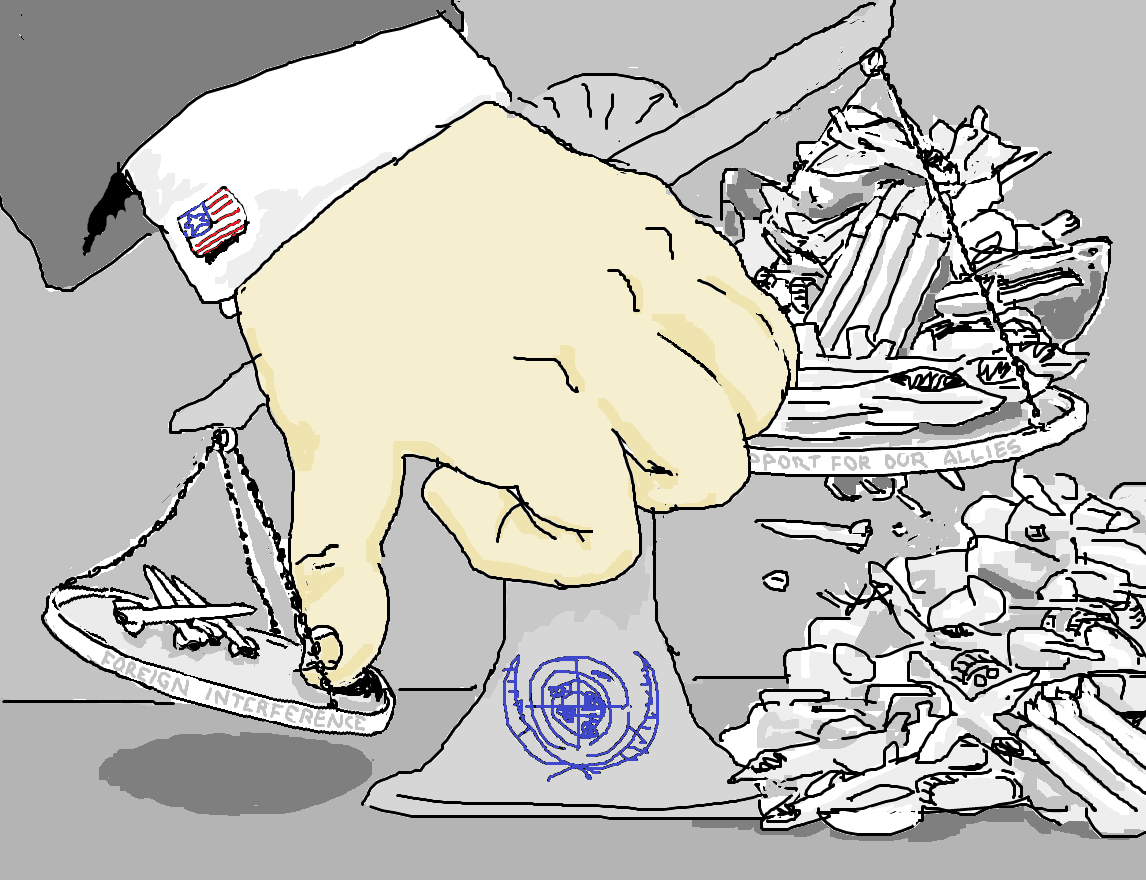
by Kathy Kelly
May 21, 2018
On May 10, the Kingdom of Saudi Arabia informed the UN Security Council and UN Secretary General Antonio Guterres that Saudi Air Defenses intercepted two Houthi ballistic missiles launched from inside Yemeni territory targeting densely populated civilian areas in Riyadh, the Saudi capital. No one was killed, but an earlier attack, on March 26, 2018, killed one Egyptian worker in Riyadh and an April 28 attack killed a Saudi man.
Unlike the unnumbered victims of the Saudis’ own ongoing bombardment of Yemen, these two precious, irreplaceable lives are easy to document and count. Death tolls have become notoriously difficult to count accurately in Yemen. Three years of U.S.-supported blockades and bombardments have plunged the country into immiseration and chaos.
In their May 10th request, the Saudis asked the UN to implement “all relevant Security Council resolutions in order to prevent the smuggling of additional weapons to the Houthis, and to hold violators of the arms embargo accountable.” The letter accuses Iran of furnishing the Houthi militias with stockpiles of ballistic missiles, UAVs and sea mines. The Saudis’ letter omits mention of massive U.S. weapons exports to Saudi Arabia and the United Arab Emirates (UAE).
The Security Council resolutions invoked by the Saudis name the Houthis as a warring party in Yemen and call for an embargo, so the Houthis can’t acquire more weapons. But these Resolutions don’t name the Saudis as a warring party in Yemen, even though Crown Prince Mohammed bin Salman has, since March 2015, orchestrated Saudi involvement in the war, using billions of dollars of weapons sold to the Saudis and the UAE by the U.S. and the UK.
The Saudis have an undeniable right to call on the UN to work toward preventing the Houthis from acquiring ballistic weapons that could be fired into Saudi Arabia, but the air, sea and water blockade now imposed on Yemen brutally and lethally punishes children who have no capacity whatsoever to affect Houthi policies. What’s more, the U.S. military, through midair refueling of Saudi and Emirati warplanes, is directly involved in devastating barrages of airstrikes while the UN Security Council essentially pays no heed.
As Yemeni civilians’ lives become increasingly desperate, they become increasingly isolated, their suffering made invisible by a near-total lack of Western media interest or attention. No commercial flights are allowed into the Sana’a airport, so media teams and human rights documentarians can’t enter the areas of Yemen most afflicted by airstrikes. The World Food Program (WFP) organizes a weekly flight into Sana’a, but the WFP must vet passengers with the Saudi government. Nevertheless, groups working in Yemen, including Amnesty International, Médecins Sans Frontières (MSF), Save the Children, Oxfam, and various UN agencies do their best to report about consequences of the Saudi-Emirati led coalition’s blockade and airstrikes.
On May 18th, Médecins Sans Frontières (MSF) issued a report about airstrikes against the Saada governorate which notes that “in the past three years, the coalition has carried out 16,749 air raids in Yemen, i.e. an average of 15 a day. Almost a third of the raids have hit non-military sites.”
Earlier in May, MSF responded to a series of Saudi-Emirati coalition led airstrikes on May 7th which struck a busy street in the heart of Sana’a, killing six people and injuring at least 72.
“Civilians, including children, were killed and maimed because they were in the wrong place at the wrong time,” said João Martins, MSF head of mission in Yemen. “No-one should live in fear of being bombed while going about their daily life; yet again we are seeing civilian victims of airstrikes fighting for their lives in hospitals.”
Lacking access to food, clean water, medicine and fuel, over 400,000 Yemeni children are, according to Save the Children, at imminent risk of starvation. “Most of them will never see a health clinic or receive treatment,” says Kevin Watkins, the organization’s UK Director. “Many of those who survive will be affected by stunting and poor health for the rest of their lives.” Watkins says the Saudi-UAE led coalition is using economic strangulation as a weapon of war, “targeting jobs, infrastructure, food markets and the provision of basic services.”
On March 22, 2018, Amnesty International called for an end to the flow of arms to the Saudi-led coalition attacking Yemen. “There is extensive evidence that irresponsible arms flows to the Saudi Arabia-led coalition have resulted in enormous harm to Yemeni civilians,” their statement says. “But this has not deterred the USA, the UK and other states, including France, Spain and Italy, from continuing transfers of billions of dollars’ worth of such arms.”
The UN Charter begins with a commitment to save succeeding generations from the scourge of war. The UN Security Council has miserably failed the Yemeni people by allowing the scourge of war to worsen, year by year. By approving biased resolutions that neglect to even name the most well-funded and sophisticated warring parties in Yemen — Saudi Arabia; the United Arab Emirates; the United States — the Security Council promotes the intensification of brutal, apocalyptic war and enables western war profiteers to benefit from billions of dollars in weapon sales. Weapon manufacturers such as Raytheon, Lockheed Martin and Boeing then pressure governments to continue selling weapons to two of their top customers, Saudi Arabia and the United Arab Emirates.
Earnest, honest and practical steps to stop the war are urgently needed. The U.N. must abandon its biased role in the Yemen conflict, so it can broker a peace in which the Houthi minority can retain some dignity and representation in majority-Sunni Yemen, which even before the Houthi uprising lacked any legitimate elected leader. The Houthis must be given an option to lay down arms without landing in any of the clandestine prisons operated by the UAE in Yemen, reported to be little more than torture camps. Even more urgent, the violence and economic strangulation by foreign invaders must cease.
At the very least, citizens in countries supplying weapons to the Saudi-Emirati coalition must demand their legislators forbid all future sales. The time for determined action is running out in the U.S. as the State Department is already taking preliminary steps toward a massive, multibillion-dollar sale of weapons to Saudi Arabia and the United Arab Emirates. The package is said to include tens of thousands of precision-guided munitions from Raytheon.
Yemeni civilians, especially children, pose no threat whatsoever to the U.S. Yet, U.S. support for airstrikes, blockades and the chaos inevitably caused by prolonged war threatens Yemeni civilians, especially vulnerable children. They have committed no crime but are being punished with death.
cartoon: S. Reynolds (CC-BY-SA 4.0)
Kathy Kelly (kathy@vcnv.org) co-coordinates Voices for Creative Nonviolence (www.vcnv.org)
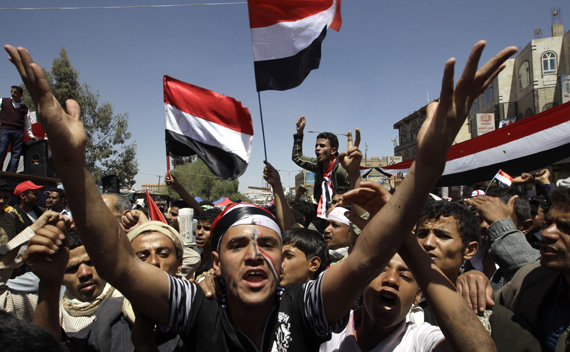
December 31, 2017
People living now in Yemen’s third largest city, Ta’iz, have endured unimaginable circumstances for the past three years. Civilians fear to go outside lest they be shot by a sniper or step on a land mine. Both sides of a worsening civil war use Howitzers, Kaytushas, mortars and other missiles to shell the city. Residents say no neighborhood is safer than another, and human rights groups report appalling violations, including torture of captives. Two days ago, a Saudi-led coalition bomber killed 54 people in a crowded market place.
Before the civil war developed, the city was regarded as the official cultural capital of Yemen, a place where authors and academics, artists and poets chose to live. Ta’iz was home to a vibrant, creative youth movement during the 2011 Arab Spring uprising. Young men and women organized massive demonstrations to protest the enrichment of entrenched elites as ordinary people struggled to survive.
The young people were exposing the roots of one of the worst humanitarian crises in the world today.
They were sounding an alarm about the receding water tables which made wells ever harder to dig and were crippling the agricultural economy. They were similarly distressed over unemployment. When starving farmers and shepherds moved to cities, the young people could see how the increased population would overstress already inadequate systems for sewage, sanitation and health care delivery. They protested their government’s cancellation of fuel subsidies and the skyrocketing prices which resulted. They clamored for a refocus on policy away from wealthy elites and toward creation of jobs for high school and university graduates.
Despite their misery, they steadfastly opted for unarmed, nonviolent struggle.
Dr. Sheila Carapico, an historian who has closely followed Yemen’s modern history, noted the slogans adopted by demonstrators in Ta’iz and in Sana’a, in 2011: “Remaining Peaceful Is Our Choice,” and “Peaceful, Peaceful, No to Civil War.”
Carapico adds that some called Ta’iz the epicenter of the popular uprising. “The city’s relatively educated cosmopolitan student body entertained demonstration participants with music, skits, caricatures, graffiti, banners and other artistic embellishments. Throngs were photographed: men and women together; men and women separately, all unarmed.”
In December of 2011, 150,000 people walked nearly 200 kilometers from Ta’iz to Sana’a, promoting their call for peaceful change. Among them were tribal people who worked on ranches and farms. They seldom left home without their rifles, but had chosen to set aside their weapons and join the peaceful march.
Yet, those who ruled Yemen for over thirty years, in collusion with Saudi Arabia’s neighboring monarchy which fiercely opposed democratic movements anywhere near its borders, negotiated a political arrangement meant to co-opt dissent while resolutely excluding a vast majority of Yemenis from influence on policy. They ignored demands for changes that might be felt by ordinary Yemenis and facilitated instead a leadership swap, replacing the dictatorial President Ali Abdullah Saleh with Abdrabbuh Mansour Hadi, his vice-president, as an unelected president of Yemen.
The U.S. and neighboring petro-monarchies backed the powerful elites. At a time when Yemenis desperately needed funding to meet the needs of starving millions, they ignored the pleas of peaceful youths calling for demilitarized change, and poured funding into “security spending” – a misleading notion which referred to further military buildup, including the arming of client dictators against their own populations.
And then the nonviolent options were over, and civil war began.
Now the nightmare of famine and disease those peaceful youths had anticipated has become a horrid reality, and their city of Ta’iz is transformed into a battlefield.
What could we wish for Ta’iz? Surely, we wouldn’t wish the terror plague of aerial bombardment to cause death, mutilation, destruction and multiple traumas. We wouldn’t wish for shifting battle lines to stretch across the city and the rubble in its blood-marked streets. I think most people in the U.S. wouldn’t wish such horror on any community and wouldn’t want people in Ta’iz to be singled out for further suffering. We could instead build massive campaigns demanding a U.S. call for a permanent cease fire and an end of all weapon sales to any of the warring parties. But, if the U.S. continues to equip the Saudi-led coalition, selling bombs to Saudi Arabia and the UAE and refueling Saudi bombers in midair so they can continue their deadly sorties, people in Taiz and throughout Yemen will continue to suffer.
The beleaguered people in Ta’iz will anticipate, every day, the sickening thud, ear-splitting blast or thunderous explosion that could tear apart the body of a loved one, or a neighbor, or a neighbors’ child; or turn their homes to masses of rubble, and alter their lives forever or end their lives before the day is through.
Kathy Kelly (kathy@vcnv.org) co-coordinates Voices for Creative Nonviolence (www.vcnv.org)
Photo Credit: REUTERS/Ammar Awad
July 21, 2017
“I come and stand at every door
But none shall hear my silent tread
I knock and yet remain unseen”
-Nazim Hikmet
On July 18, 2017, at a U.S. Senate Foreign Relations Committee hearing focused on “The Four Famines: Root Causes and a Multilateral Action Plan,” Republican Senator Todd Young, a former Marine, asked officials present if ongoing war in Yemen could fail to exacerbate the catastrophe developing there – one of four countries, along with Southern Sudan, Nigeria, and Somalia, set to collectively lose 20 million people this year, one third the death toll of WWII, from conflict-driven famine. Yemen is being bombarded and blockaded, using US-supplied weapons and vehicles, by a local coalition marshaled by U.S. client state Saudi Arabia. Yemen’s near-famine conditions, with attendant cholera outbreak, are so dire that in Yemen it is estimated a child dies every 10 minutes of preventable disease.
At the hearing, Senator Young held aloft a photo of a World Food Program warehouse in Yemen, which was destroyed in 2015. Senator Young asked David Beasley, Executive Director of the World Food Program, to name the country responsible for the airstrike that destroyed the food warehouse. Mr. Beasley said the Saudi-led coalition blockading Yemen had destroyed the warehouse, along with the relief supplies it contained.
A July 2016 Human Rights Watch report documented 13 civilian economic structures destroyed by Saudi coalition led bombing between March 2015 and February 2016, “including factories, commercial warehouses, a farm, and two power stations. These strikes killed 130 civilians and injured 171 more. The facilities hit by airstrikes produced, stored, or distributed goods for the civilian population including food, medicine, and electricity—items that even before the war were in short supply in Yemen, which is among the poorest countries in the Middle East. Collectively, the facilities employed over 2,500 people; following the attacks, many of the factories ended their production and hundreds of workers lost their livelihoods.”
Asked about the Saudi coalition’s destruction of four cranes needed to offload relief supplies in Yemen’s port city Hodeidah, Mr. Beasley clarified that the loss of the cranes has vastly impeded WFP efforts to deliver food and medicines. Senator Young read from Mr. Beasley’s June 27th letter to the Saudi government, only the latest of multiple requests, asking that the WFP be allowed to deliver replacement cranes. Mr. Beasley said the Saudis had provided no reply. Senator Young noted that, in the three weeks since this last letter had been sent, more than 3,000 Yemeni children had died of preventable, famine-related causes.
Medea Benjamin, of the antiwar campaign Code Pink, was at the “Four Famines” hearing, and later thanked Sen. Young for rebuking the Saudi government. He emphasized how wrongful it has been to impose a blockade,
bomb civilian infrastructure, and kill thousands of people.
One day later, the United Nations Refugee Agency (UNHCR) reported on a July 19th coalition airstrike in Yemen, which killed 20 civilians—including women and children—while they were fleeing violence in their home province. The report claimed more than two million internally displaced Yemenis “fled elsewhere across Yemen since the beginning of the conflict, but … continue to be exposed to danger as the conflict has affected all of Yemen’s mainland governorates.”
On July 14, the US House of Representatives overwhelmingly passed two amendments to the National Defense Authorization Act (NDAA) that would potentially end US participation in the Yemeni civil war. In the past, the White House has provided refueling and targeting assistance to the Saudi-led coalition without congressional authorization. Since October of 2016, the US has doubled the number of jet refueling maneuvers carried out with Saudi and United Arab Emirate jets. The Saudi and UAE jets fly over Yemen, drop bombs until they need to refuel, then fly back to Saudi airspace where US jets perform mid-air refueling operations. Next, they circle back to Yemen and resume bombing.
In the summer of 2006, I joined peace campaigner Claudia Lefko at a small school she helped found in Amman, Jordan. The school served children whose families were refugees, having fled postwar chaos in Iraq. Many of the children have survived war, death threats, and displacement. Claudia had worked with children in her hometown of Northampton, Massachusetts, to prepare a gift for the Iraqi refugee children at the Jordanian school. The gift consisted of strings of paper origami cranes, folded in memory of a Japanese child, Sadako, who had died from radiation sickness after the bombing of her home city, Hiroshima. In her hospital bed (the story goes), Sadako occupied her time attempting to fold 1,000 paper cranes, a feat she hoped would earn her the granting of a special wish, that no other child would ever suffer a similar fate. Sadako succumbed too rapidly to complete the task herself, but Japanese children hearing of her folded many thousands more cranes, and the story has been told for decades in innumerable places, making the delicate paper cranes a symbol for peace throughout the world. The Turkish writer, Nazim Hikmet, wrote a poem, since set to music, about the story. Its words are on my mind today, as I think of the malnourished children from the countries of the terrible Four Famines, and from other conflict-torn, US-targeted countries such as Iraq, and Afghanistan. I think of their months or years of terrible hunger. Their stories may have ended already during the first half of 2017.
“I need no fruit I need no rice
I need no sweets nor even bread
I ask for nothing for myself
For I am dead for I am dead”
The song about “The Little Girl of Hiroshima” imagines a child who comes and stands at every door, unheard and unseen. In reality, we the living can choose to approach the doors of elected representatives, of our neighbors, or stay at home. We can choose whether or not to be heard and seen. Robert Naiman at Just Foreign Policy points out that many people don’t know yet that the House has voted to prohibit US participation in the Saudi war in Yemen. We can focus on progress made, publicize the House votes on social media, push for a House roll call vote on the Davidson-Nolan prohibitions on Defense Appropriation, and push the Senate to pass the same provisions as the House. I personally oppose all defense appropriations (I have refused all payment of federal income tax since 1980). I recognize that legislative activism, at the heart of an empire addicted to war, is a tool of limited use; but considering the arriving disaster for which, as too few yet understand, 2017 may be hereafter remembered as the worst famine year in post-WWII history – we have no luxury to reject any tools presented to us.
Billions, perhaps trillions, will be spent to send weapons, weapon systems, fighter jets, ammunition, and military support to the region, fueling new arms races and raising the profits of U.S. weapon makers. But, we can choose to stand at the doors of our leaders and of our neighbors, honoring past sacrifices and the innocent lives we were unable to save, as we redouble efforts to stop war makers from constantly gaining the upper hand in our lives.
We can never reverse the decisions to drop atomic bombs on Hiroshima and Nagasaki, and we cannot prevent all of the dying that is set to come, this fateful summer, in the countries of the Four Famines. In the song, lost Sadako, long beyond saving even as she folded paper in her bed, doesn’t ask us to erase her own terrible loss, but to achieve the change we can, and to lose no more time in achieving it:
“All that I need is that for peace
You fight today you fight today
So that the children of this world
Can live and grow and laugh and play”
Kathy Kelly (Kathy@vcnv.org) co-coordinates Voices for Creative Nonviolence (www.vcnv.org)